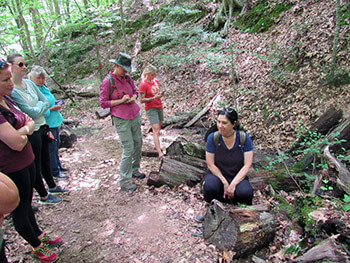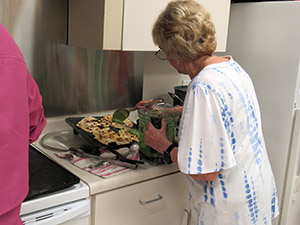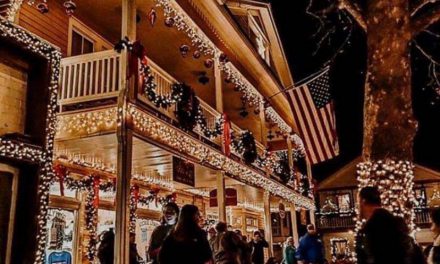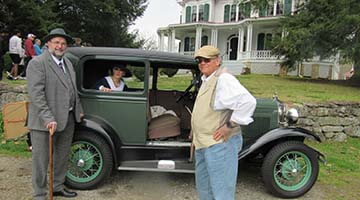
Cara-Lee Langston, kneeling, points out woody mushrooms to Wildcraft Kitchen students last month on the Ed Dodd Trail at Elachee Nature Science Center.
If it were legal to forage on a deserted island on Lake Lanier, a keen-eyed scavenger might find platefuls of nature’s bounty. Wild mushrooms, berries, muscadines leaves and grapes, and a variety of greens and roots could perceivably nourish a castaway for days or weeks. Just add fish.
The lake, its estimated 160 islands and shoreline environ, lie within the Southern Appalachian botanical region, rich in native edible plants. “There are hundreds of native trees and plants, many of which can be used for food and medicine,” according to herbalist educator Cara-Lee Langston, who recently led a foraging and cooking class at Elachee Nature Science Center in Gainesville.
Langston, a forager, nutrition advisor, and wellness cook, left her native South Africa years ago, finding herself in a foreign land without seaweed, tropical fruits and other edibles she grew up with. “I was homesick,” she said. But, as she ventured into the woods and meadows of her new home, she discovered the flora and fauna of the Southern mountains. “I try to inspire people that no matter where you come from or where you go, you can always feel at home with nature” she said.
Langston, who holds a Master’s Degree in Nutrition and Integrative Health and certifications in herbalism, wild mushroom safety, and wilderness first aid, founded Wildcraft Kitchen in Clayton. In three and a half hours at Elachee, she led 17 followers from the classroom to the woods and into the kitchen where they teamed up to cook a delicious meal featuring wild plants Langston picked in advance, like Stinging Nettles. When she lifted the thorny vines from her brown paper bag, the nascent natural cooks wondered “Are we going to eat that?” She later blanched the viny shoots, plunged them into ice water and the tiny thorns fell off. Who would have guessed the “nuisance plant” would blend with other ingredients to produce a vibrant green flavorful pesto?
On the pre-meal hike, Langston stopped frequently to point out edible and medicinal plants on edges of the Ed Dodd Trail. In slightly more than half a mile, she found 16 plants that can be eaten or used in healing. Although she had never set foot on that trail before, she said she felt confident she would find plenty because it runs through the lush region. Since the Chicopee Woods Nature Preserve, where Elachee is situated, is a protected area, there was no harvesting, except for a few wild blueberries.
Class participants shifted gazes from overhead to the forest floor, from dead logs to thorny vines as Langston revealed the human uses of plants rarely noted by inexperienced foragers. For instance, the leaves of the Sourwood tree produce a tart, lemony flavor and can be mixed in salads. Native Cherokees would chew the leaves as a tonic for intestinal distress, nervousness and other maladies. Langston noted that honey that bees make from Sourwood flowers “is the best honey in the world.”
The mild tasting leaves and stems of Wild Ginger, also known as Little Brown Jug, can be brewed into a tea or blended into a cream. Its roots can be dried and ground into a spice.
Hikers were surprised to learn that an intrusive leafy vine that often tangles up woodsy yards can be delectable on the hors d’oeuvre table. Wild Muscadine leaves wrapped around a sticky mixture of rice, herbs, spices and nuts make backyard-sourced dolmas. “You can also use kudzu,” Langston said.
Many Southerners go blackberry-picking at some point in their lives, but few bother to pick the leaves before the berries ripen. When fermented, dried and crushed, the leaves can be steeped into a tea similar to black tea without the caffeine. They can also be eaten raw.
Langston also spotted tiny wild low bush blueberries, ripe and ready to eat.
Along moist, shady trail edges, Langston eyed several varieties of wild mushrooms: Chanterelles, Woody, and Woods Ear. She cautioned foragers to “get a 120 percent positive ID” on any wild plant, especially mushrooms. Mistaking a toxic Morel-lookalike for the edible, tasty genuine fungi can cause more than a bellyache. Langston added that sometimes even positively identified edible mushrooms should be left alone. “If it looks slimy, it is slimy. If it looks like it has holes and bugs, it has holes and bugs.”
Langston stopped often to show hikers other Chicopee Woods treasures including:
- Bloodroot, used to burn off warts; offers other potent clinical uses.
- Cucumber root, tastes like cucumbers and water chestnuts
- Paw Paws, look like small green mangos and produce a banana custard flavor
- Milax, roots can be boiled or roasted like potatoes
- Greenbriar, perceived as an invasive, produces early spring shoots like asparagus.
Class participants, most from the Lake Lanier area, remarked that they had overlooked some of the plants in their own backyards without recognizing their culinary or medicinal uses.

A Wildcraft Kitchen student spoons pesto made from Stinging Nettles, Lambsquarters and other ingredients onto flatbread on the griddle.
Back in the Elachee kitchen, Langston directed a whirlwind cooking school. Teams rolled out flatbread, blended wild greens into pesto, and sauteed Woods Ear and rehydrated Chanterelles for risotto. Langston mixed a salad of Wood Sorrel, cornflowers, nasturtiums, local lettuces and kale. Diners later swooned about the hearty, earthy umami of the mushrooms in the risotto and the tangy, citrusy flavor of Wood Sorrell in the salad. But it was the pesto, made with the de-thorned Stinging Nettles, Lambsquarters, ground pumpkin seed and fresh Parmesan cheese, that pleased the palate most. Well … at least until Langston brought out a cast iron skillet bubbling with cobbler stuffed with local blueberries. A dollop of cream shaken to thickness in a jar topped it off.
The trail-to-kitchen morning satisfied participants on many levels: intellectually, physically, spiritually, and of course gustatorily.
The Wildcraft Kitchen class was part of the June Discovery Saturday program at Elachee Nature Science Center. Another Wildlife Kitchen class may be scheduled this fall, according to Maranda McGaha, Elachee program director. Check www.elachee.org for upcoming events. For information about Wildcraft Kitchen’s other offerings, see www.wildlifekitchenga.com.
Tips for safe & ethical wild plant foraging
- Always get a 120 percent positive ID. Look at every characteristic of plants or fungi. “When in doubt, leave it out.”
- Watch throughout the seasons. Many plants are not easily identified until you see them flower or fruit.
- Don’t take too much. Never take more than 10 percent of what you find.
- Ask for permission. It is illegal to forage in city and state parks. Forging on national forest or federal lands may require a special permit.
- Avoid contaminated areas. Do not harvest in polluted areas like cities and roadsides. Watch for industrial, chemical, human/pet/wildlife waste.
Source: Wildcraft Kitchen
Photos: by Jane Harrison







